Guest Posts Do Not Necessarily Reflect the Views of the Sentinel
THE STANDARD TO ASSESS
VICE PRESIDENT KAMALA HARRIS
by James M. Thunder
President Biden has assigned the following five jobs to Vice President Kamala Harris:
- Leading the diplomatic effort with other countries on issues related to the southern border; address of March 24, 2021, Remarks by President Biden and Vice President Harris in a Meeting on Immigration | The White House. (I was surprised when I read the original document to learn that she was not made “southern border czar” but was given this limited scope.)
- Power grid; The American Jobs Plan Broadband internet as part of infrastructure reform; address to Joint Session of Congress, April 18, 2021, Remarks as Prepared for Delivery by President Biden — Address to a Joint Session of Congress | The White House
- Chair the National Space Council, May 1, 2021, statement by senior administration officials on background, Harris to place “personal stamp” on National Space Council – SpaceNews
- Leading a “national vaccination tour” to encourage people in the South and Midwest to get vaccinated against Covid, June 2, Remarks by President Biden,
- Working with Congress to pass legislation nationalizing/federalizing voting laws in the states (concerning H.R. 1, the “For the People Act” a/k/a John Lewis Voting Rights Advancement Act); address of Biden June 2 on Tulsa Massacre, Remarks by President Biden Commemorating the 100th Anniversary of the Tulsa Race Massacre | The White House; statement of Harris, June 1, 2021, Statement from Vice President Kamala Harris on Administration’s Voting Rights Efforts | The White House
Rather than looking at how she is dealing with these assignments, either singly or together, let us consider the standard established over the course of the life of this nation by which she can be assessed.
We can safely say that there was one standard before 1939 and a different one after. Before 1939, the U.S. Constitution set two roles for the vice president, both in Art. I, Sec. 3, cl 4: the incumbent would succeed to the presidency if a vacancy occurred and would preside over the Senate as the “president of the Senate,” casting a vote only to break a tie.
Before the Twelfth Amendment, the first role was very dicey since the vice president was the person who came in second in Electoral College voting for president (Art. II, Sec. 1, cl 3) and could be of quite a different mindset on the issues of the day. Thus, in the 1796 election, Jefferson became Adams’ vice president. In the 1800 election, the Electoral College voted a tie (73 votes each) for Jefferson and Burr. The choice went to the House which voted one vote per state. Jefferson beat Burr on the 36th ballot. Burr became his vice president. The Twelfth Amendment was ratified in 1804 in time for the 1804 election.
The Twelfth Amendment established a third constitutional role for the vice president. As president of the Senate, he or she would “open all the certificates [of the Electoral College] and the votes shall then be counted.”
With respect to tie-breaking, as of March 19, 2021, the vice presidents have voted to break a tie 277 times. VPTies.pdf (senate.gov)
Before 1945, the vice president was not regarded as part of the President’s Cabinet. Here are some examples, graphically displayed:
The first photo of a presidential cabinet, Polk’s in 1846. Secretary of State Buchanan is absent. Seated, left to right: Attorney General Mason, Secretary of War Marcy, the President, Secretary of the Treasury Walker. Standing: Postmaster General Johnson, Secretary of the Navy Bancroft.
President Theodore Roosevelt’s Cabinet, 1907. Clockwise, from Roosevelt: Cortelyou, Secretary of the Treasury; Bonaparte, Attorney General; Metcalf, Secretary of the Navy; Straus, Secretary of Commerce; Wilson, Secretary of Agriculture; Garfield, Secretary of the Interior; von Lengerke Meyer, Postmaster General; Taft, Secretary of War; Root, Secretary of State.
President Franklin D. Roosevelt’s Cabinet, 1945. From left to right around the table: Secretary of Agriculture Wickard, Secretary of Labor Perkins, Secretary of Commerce Wallace (formerly Vice President), unidentified, Secretary of the Interior Ickes, unidentified, Secretary of War Stimson, Secretary of State Stettinius, the President, Secretary of the Treasury Morgenthau, Attorney General Biddle, unidentified. President Roosevelt and his Cabinet | Harry S. Truman (trumanlibrary.gov)
By contrast, starting with President Truman, the vice president is portrayed as part of the President’s Cabinet:
President Truman’s Cabinet, Jan. 14, 1949. L to R: Secretary of Defense Forrestal, the President, Vice President Barkley, Treasury Secretary Snyder. Rear: Commerce Secretary Sawyer, Acting Secretary of State Lovett, Interior Secretary Krug, Attorney General Clark, Agricultural Secretary Brannan, Labor Secretary Tobin, Postmaster General Donaldson.
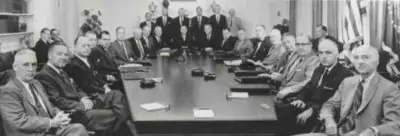
President Eisenhower’s Cabinet, Aug. 7, 1959: Clockwise: Deputy Ass’t Morgan, Amb. Lodge, Interior Secretary Seaton, Treasury Secretary Anderson, Vice President Nixon, Attorney General Rogers, Acting Commerce Secretary Mueller, Health Education Welfare Secretary Flemings, AEC Chair McCone, Budget Director Stans, Civil Defense Director Hoegh, Labor Secretary Mitchell, Postmaster General Summerfield, Secretary of State Herter, the President, Defense Secretary McElroy, Agriculture Secretary Benson, Cabinet Secretary Gray, Presidential Assistant Personel.
[I have not been able to find a photo of President Johnson’s Cabinet after the 1964 election with Vice President Humphrey.]
President Kennedy’s first Cabinet meeting, Jan. 26, 1961: Postmaster General Day, U.S. Ambassador to the UN Stevenson, Vice President Johnson, Secretary of Defense McNamara, Secretary of Agriculture Freeman, Secretary of Labor Goldberg, Secretary of Health, Education and Welfare Ribicoff, Secretary of Commerce Hodges, Attorney General R.F. Kennedy, Secretary of State Rusk, the President, Secretary of the Treasury Dillon, Secretary of the Interior Udall.
John Adams described his vice presidency in the following words: “In this I am nothing.” John Nance Garner served as FDR’s vice president for the first two terms. Although as former Speaker of the House he helped FDR move his New Deal legislative agenda, he famously said that the vice presidency was not worth a bucket of warm piss. Former New York Governor Nelson Rockefeller, who served as President Ford’s vice president from 1974-1976, dismissed the vice presidency, because Ford had not fulfilled his promise to give him significant roles, with the words, “I go to funerals. I go to earthquakes.” If I were to provide a picture of Rockefeller in the Ford Cabinet, it would not negate his perspective. His words are a reminder to us that, whatever responsibilities a vice president has is at the sole prerogative of the president.
Now let’s turn to the evolution in the job of vice president starting in 1939:
- Under the 1939 Reorganization Act, an “Office of the Vice President” with staff and budget was created.
- During World War II, FDR assigned to Vice President Henry Wallace the following duties: Chair, Board of Economic Warfare; Chair, Supply Priorities and Allocation Board; member, Top Policy Group (on development of nuclear weapons); member, War Production Board. And he traveled throughout Central and South America.
- In 1949, Congress made the vice president a member of the National Security Council which had been created in 1947.
- During Truman’s full term, Vice President Alben W. Barkley attended Cabinet meetings and, as former Senate majority leader, attended the President’s, weekly legislative conferences. He served as the Truman Administration’s primary spokesperson.
- During the Eisenhower Administration in the 1950s, when Nixon was Vice President, the vice president became identified more with the Executive, than the Legislative, Branch; the Office of the Vice President was located in the Old Executive Office Building (now named Eisenhower Executive Office Building).
- Nixon attended Cabinet meetings, toured the Far East in 1953. Although one biographer, Irwin Gellman, has said he had significant responsibilities and was the “first modern vice president, when President Eisenhower was asked to describe Nixon’s contributions, Eisenhower replied: “If you give me a week, I might think of one.”
- In 1967, the 25th Amendment was ratified that provided for filling a vacancy in the position of vice president. Ford and Rockefeller became vice presidents in this fashion.
- During President Johnson’s full term, he was at odds with Vice President Humphrey over the Vietnam War and withdrew his support for Humphrey’s role for the Administration in the area of civil rights; Humphrey did, however, travel to the Far East, the UK and Africa.
- In 1975, for the first time, the vice president (it was Rockefeller at the time) had an official residence, on Observatory Circle; before that, the vice president stayed in hotels and private homes.
We turn next to 1977, when, with the exception of FDR-Wallace and Truman-Barkley, students of history state the modern vice presidency began with President Carter and Vice President Mondale. Carter gave Mondale an office in the West Wing. Mondale was in the President’s inner circle and was his chief adviser, and the President ensure he had access to people and information. The two began the tradition of weekly lunches. Mondale traveled throughout the country and the world. He was a “trouble shooter” for the Administration.
What assignments have vice presidents since Mondale had? I will be brief.
Vice President George H.W. Bush was assigned by President Reagan to chair a task force on deregulation (affecting broadcasting, finance, mining, and more) and another on international drug smuggling. Bush also oversaw national security crisis management organization and toured NATO countries in a successful effort to garner their support for the deployment of Pershing II missiles.
Vice President Dan Quayle was chair of the National Space Council, head of the Council on Competitiveness, and made official trips to 47 countries.
President Clinton agreed to recognize Vice President Gore as his top adviser on nominations. Gore did not have an easy time trying to be Clinton’s chief adviser generally since he had to compete with First Lady Hillary Clinton. Gore negotiated the Kyoto Protocol on climate change and promoted the Internet.
Vice President Cheney was very active in President George W. Bush’s War on Terror. He was intimately involved with the Administration’s legislative agenda; he had an office on the House side of the Capital and two offices on the Senate side.
Vice President Biden was asked by President Obama to lead the effort to draw down troops in Iraq. (He did draw down troops and ISIS was re-established.) He was also asked to oversee the government’s response to the 2008 Great Recession. (There were never any “shovel ready” projects.)
In 2017 President Trump reestablished the National Space Council, with Vice President Pence as its chair, that had been dormant since the George H.W. Bush term ended in 1993. Trump named Pence as chair of the task force on the coronavirus, including Operation Warpspeed to develop and distribute vaccines.
Observations
- How shall we assess Biden, not Harris, in the assignments Biden has given Harris? How would you compare/contrast them with those given Mondale and later vice presidents? At least one commentator suggested that Biden has, wittingly or not, set up Harris to fail.
- There is nothing that requires a vice president to accept any assignments from the President —except an ambition to become president by holding oneself out as capable of domestic and foreign policy work. For example, Vice President Bush used the assignments from Reagan to court conservatives for a presidential run.
- Current White House documents consistently refer to the current Administration as “Biden-Harris” not “Biden,” priming the American voters for an upcoming Harris presidency.
- Of the 48 individuals who have served as vice president (Harris is the 49th), three were elected in their own right after having first succeeded to the presidency: Teddy Roosevelt, Coolidge, and Truman. Only six became president other than through the president’s death or resignation: Adams, Jefferson, Van Buren, Nixon, George H.W. Bush, Biden. And two of these, Nixon and Biden, did not win the presidency immediately following the end of their vice presidency.



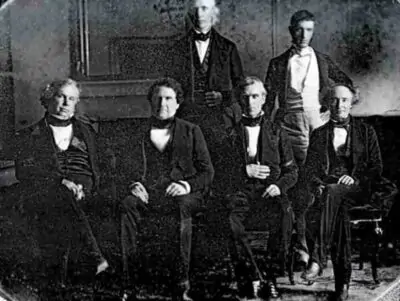
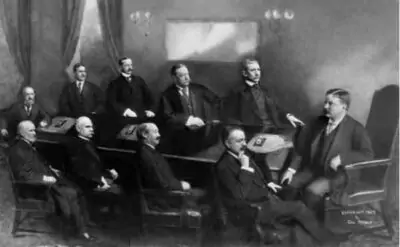
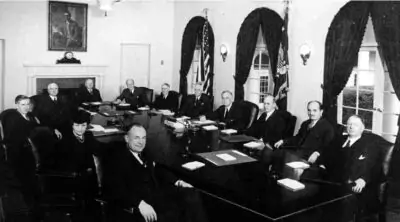
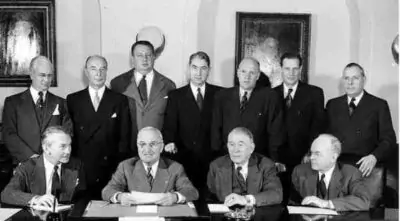
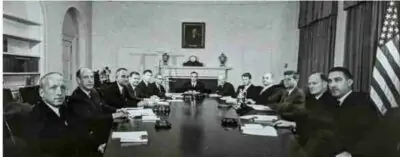

I’m just Glad that Heel up Harris is totally incompetent. If he had any brains, she would would be even more dangerous. If she becomes President, the Liberals will come after her with Shovels and Pitchforks. So stock up on popcorn.